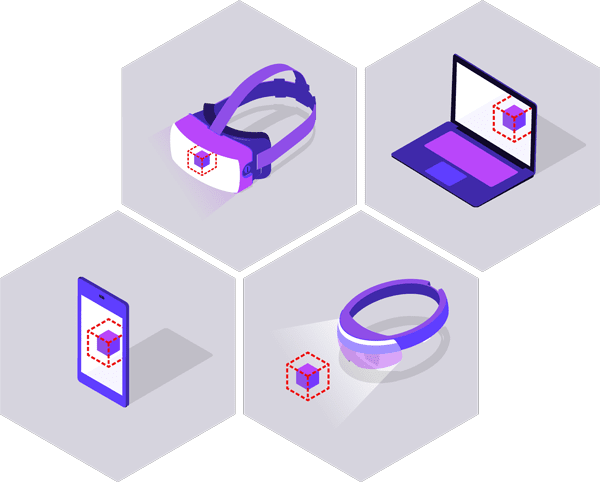
The Problem
Teams and owners of sporting IPs want to extend their reach beyond the physical stadium to reach their global fanbase.
New generations of fans want to create shared social spaces across a multitude of devices. Current standards of coverage are rooted in a linear “one size fits all approach
Stadiums can be costly to access for fans with travel, tickets and accomodation all featuring in making it expensive to get to the stadium with your friends.
There is a discrepancy in the spend between esports fans and traditional sports fans with significant monetisation opportunities being left on the table for IP owners.

Our Solution
Home Stadium is a groundbreaking technology platform that uses live and historic data to create meaningful and highly personalised mixed-reality experiences for esports and sports fans alike.
It incorporates immersive experiences for remote audiences that seamlessly stretch across virtual and physical spaces, multiple displays, mobile devices, VR video telepresence and augmented reality overlays, enabling viewers to teleport in between the live arena, virtual game worlds and augmented living rooms.
Responding to the fans’ eagerness to learn and to become better players, Home Stadium creates cross-reality spaces in which fans immerse themselves in high fidelity statistics, visualisations and data-driven stories that give them deep insights into the live match.
Home Stadium experiences are tailored to each viewer’s interests, fully interactive, and provide individualised insights by comparing each viewer’s own amateur performance statistics to those of professional players. Viewers are able to share their individual viewing experiences with other Home Stadium users and via social networks in real-time, blurring the boundaries between consuming and creating.
Home Stadium was developed as part of the UK Industrial Strategy’s Audience Of The Future Fund, a programme that supported creative companies to collaborate with each other on new immersive experiences and test them with large-scale audiences.

Next Steps
Building Home Stadium enabled us to focus on the delivery of cross-reality experiences in the digital gaming and sports entertainment market, which are two of the most popular entertainment verticals counting more than half of the world’s population as fans.
Through our creation of a fully immersive social immersive space for the fans of esports we were able to bridge the gap between the real world stadium experience or just watching a simple 2D stream. The results created an experience that was the equivalent to having a private space at a real life physical event but with all sorts of playable experiences and data driven aids that are not present at a real life event. The space had the convenience of a 2D stream but with the intimacy and fun that going to a live event with your friends is all about.

The Problem
Teams and owners of sporting IPs want to extend their reach beyond the physical stadium to reach their global fanbase.
New generations of fans want to create shared social spaces across a multitude of devices. Current standards of coverage are rooted in a linear “one size fits all approach
Stadiums can be costly to access for fans with travel, tickets and accomodation all featuring in making it expensive to get to the stadium with your friends.
There is a discrepancy in the spend between esports fans and traditional sports fans with significant monetisation opportunities being left on the table for IP owners.

Our Solution
Home Stadium is a groundbreaking technology platform that uses live and historic data to create meaningful and highly personalised mixed-reality experiences for esports and sports fans alike.
It incorporates immersive experiences for remote audiences that seamlessly stretch across virtual and physical spaces, multiple displays, mobile devices, VR video telepresence and augmented reality overlays, enabling viewers to teleport in between the live arena, virtual game worlds and augmented living rooms.
Responding to the fans’ eagerness to learn and to become better players, Home Stadium creates cross-reality spaces in which fans immerse themselves in high fidelity statistics, visualisations and data-driven stories that give them deep insights into the live match.
Home Stadium experiences are tailored to each viewer’s interests, fully interactive, and provide individualised insights by comparing each viewer’s own amateur performance statistics to those of professional players. Viewers are able to share their individual viewing experiences with other Home Stadium users and via social networks in real-time, blurring the boundaries between consuming and creating.
Home Stadium was developed as part of the UK Industrial Strategy’s Audience Of The Future Fund, a programme that supported creative companies to collaborate with each other on new immersive experiences and test them with large-scale audiences.

Next Steps
Building Home Stadium enabled us to focus on the delivery of cross-reality experiences in the digital gaming and sports entertainment market, which are two of the most popular entertainment verticals counting more than half of the world’s population as fans.
Through our creation of a fully immersive social immersive space for the fans of esports we were able to bridge the gap between the real world stadium experience or just watching a simple 2D stream. The results created an experience that was the equivalent to having a private space at a real life physical event but with all sorts of playable experiences and data driven aids that are not present at a real life event. The space had the convenience of a 2D stream but with the intimacy and fun that going to a live event with your friends is all about.








